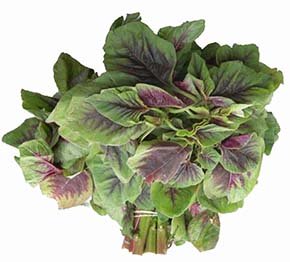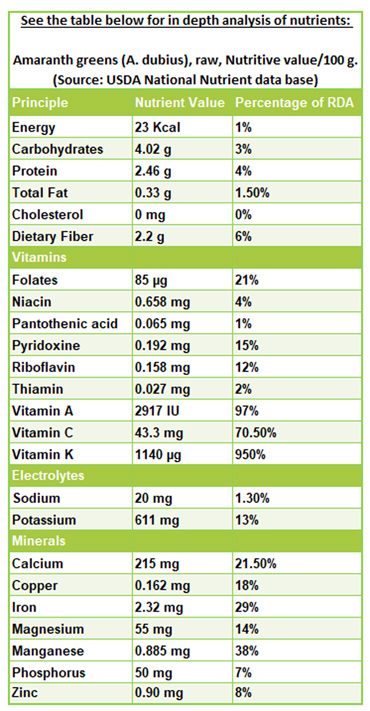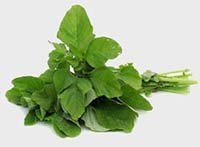Amaranth Greens Nutrition facts
Amaranth greens, nutritious leafy vegetables originating from Central America, were among the staple foods of the Aztecs and Incas during pre-Columbian times. Today, their cultivation is primarily focused in tropical climates across Latin America, Asia, and Africa.
Botanically, amaranth belongs to the Amaranthaceae family, within the genus Amaranthus. Scientific name: Amaranthus. dubius.
 |
| Amaranth- also known as Red spinach or Chinese spinach. |
Amaranth thrives in tropical and subtropical regions worldwide, with various cultivars grown specifically for either their vegetable leaves or grains.
Botanically, species of amaranth cultivated for their leaves differ from those grown for grain production, often referred to as pseudocereals. Vegetable amaranths are distinguished by traits such as short spike inflorescence, glossy brownish-black seeds, and an indeterminate growth habit. Notable leafy amaranth varieties include A. tricolor and A. dubius. Grain amaranths, on the other hand, are characterized by large apical inflorescences composed of aggregates of cymes and white or cream-colored seeds. Examples of grain amaranths include A. hypochondriacus, A. caudatus, and A. cruentus.
Health Benefits of Amaranth Greens
Amaranth leaves are a storehouse of many phytonutrients, antioxidants, minerals, and vitamins, which contribute immensely to health and wellness.
Its greens contain just 23 calories per 100g, with only traces of fats and no cholesterol.
The leaves and stems contain a good amount of soluble and insoluble dietary fibers, making leafy greens, including amaranth, often recommended by dieticians in cholesterol-controlling and weight reduction programs.
Fresh 100g of leaf amaranth contains 29% of the Daily Recommended Intake (DRI) of iron. Iron is an essential trace element required by the human body for red blood cell (RBC) production and as a co-factor for the oxidation-reduction enzyme cytochrome oxidase during cellular metabolism.
Fresh amaranth leaves are one of the richest sources of vitamin C. 100g of fresh leaves carry 43.3 mg or 70% of the recommended daily intake of this vitamin. Vitamin C is a powerful water-soluble antioxidant that plays a vital role in wound healing and helps fight against viral infections.
Amaranth contains several vital antioxidant vitamins like vitamin A (2917 IU or over 97% of daily recommended levels per 100g) and flavonoid polyphenolic antioxidants such as lutein, zeaxanthin, and β-carotene. Together, these compounds act as protective scavengers against oxygen-derived free radicals and reactive oxygen species (ROS), playing a healing role in aging and various disease processes.
Additionally, vitamin A is essential for maintaining healthy mucosa and skin and is an essential factor for ocular (eye) health. Consumption of natural vegetables and fruits rich in vitamin A and flavonoids is also known to help the body protect from lung and oral cavity cancers.
Amaranth greens perhaps have the highest concentrations of vitamin K of all the edible green-leafy vegetables. 100g of fresh greens provides 1140 μg or 950% of daily vitamin K requirements. Vitamin K plays a vital role in strengthening bone mass by promoting osteoblastic activity in bone cells. Additionally, it has an established role in patients with Alzheimer's disease by limiting neuronal damage in the brain.
Amaranth greens also contain ample amounts of B-complex vitamins such as folates, vitamin B6 (pyridoxine), riboflavin, thiamin (vitamin B-1), and niacin. A folate-rich diet helps prevent neural tube defects in newborns.
Moreover, its leaves contain more potassium than spinach. Potassium is an important component of cell and body fluids that help regulate heart rate and blood pressure.
Additionally, it has higher levels of other minerals than spinach, such as calcium, manganese, magnesium, copper, and zinc. The human body uses manganese and copper as co-factors for the antioxidant enzyme superoxide dismutase. Copper is also required for the production of red blood cells. Zinc is a co-factor for many enzymes that regulate growth and development, digestion, and nucleic acid synthesis.
In a way similar to other greens like spinach and kale, amaranth in the diet helps prevent osteoporosis (weakness of bones) and iron-deficiency anemia.
The grains used as pseudocereals, like quinoa in Europe and the USA, whereas leaf varieties are cultivated mostly as leafy vegetables in India, China, and Africa. Thanks to ongoing research studies in the area of pseudocereals, amaranthus has rediscovered itself as a promising food crop for its high nutritional value of seeds (grains) and leaves.

Selection and storage
 |
| Amaranthus dubius. Notice deep green leaves. |
Amaranths are short seasonal annual crops, with leaves ready for harvesting about 4-6 weeks after sowing the seeds.
Leafy-vegetable amaranths thrive in day temperatures above 25°C and night temperatures not lower than 15°C. They prefer fertile, free-drained alkaline soils.
In the tropics, amaranth greens are available year-round. When purchasing from markets, look for fresh leaves packed in bunches with deep-green or variegated color, displaying vitality and crispiness. Avoid wilted leaves, yellow discoloration, and spots, as well as those that are overly large and thick-stemmed, as they can be excessively bitter.
Upon arriving home, vigorously wash amaranth in a bowl of cold water, swishing thoroughly several times to remove any sand or dirt.
Preparation and serving methods
To prepare, separate the leaves and thick stems, reserving the stems to cook separately which may take longer to cook. Wash leaves in cold water before using them in cooking. Gently pat them dry using a tissue/soft cloth or swish them a few times in the air. Fresh leaves can be either chopped or used as they are in a variety of recipes. Extended cooking may result in the loss of nutrients, particularly antioxidants and vitamins.
Here are some serving tips:
You can enjoy fresh, tender leaves and shoots either raw in salads or juiced.
In the Caribbean, amaranth greens are commonly known as callaloo and are a key ingredient in the popular "callaloo soup," made with taro, ham hocks, jalapeno peppers, celery, okra, coconut milk, and crabmeat.
In mainland China, where the greens are known as yin-choy (苋菜, A. tricolor or Chinese spinach), they are often used in stir-fries and soups.
In the Indian subcontinent, the greens are referred to as chaulai (चौलाई) and are widely used in curries, stews, and mixed vegetable dishes.
In Greece, amaranth greens are popularly known as vlita and are boiled with other well-known green leafy vegetables like dandelion, mustard greens, chicory greens, etc. They are dressed with extra virgin olive oil and a squeeze of lemon juice, and served as the dish vrasta chorta.
Safety Profile
Amaranth greens, akin to spinach, contain elevated levels of oxalic acid (1.09 g/100g), a naturally occurring substance found in select vegetables. In some individuals, oxalic acid may precipitate as oxalate stones in the urinary tract.
Those with a history of oxalate urinary tract stones are advised against consuming certain vegetables from the Amaranthaceae and Brassica families. Maintaining adequate water intake is recommended to support normal urine output.
The presence of phytates and dietary fiber in the leaves can potentially hinder the absorption of calcium, iron, and magnesium.
Due to its significant vitamin-K content, individuals on anticoagulants such as "warfarin" are cautioned against incorporating amaranth into their diet as it may affect drug metabolism. (Medical disclaimer).
Also read ≻≻-
≺≺- Grain Amaranth Nutrition facts and health benefits.
≺≺- Back to Vegetables from Amaranth greens. Visit here for an impressive list of vegetables with complete illustrations of their nutrition facts and health benefits.
≺≺- Back to Home page.
Further reading:
USAID.GOV -Pdf-(Link opens in new window).
USDA National Nutrient Database.(Link opens new window)
Amaranth-Purdue University Education. (Link opens in new window).
Oxalic content of selected vegetables. (Link opens in new window).